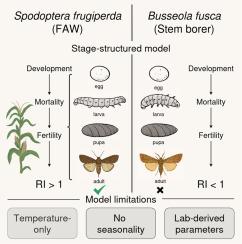When thermal risk indices work and when they don’t: A case study of two maize insect pests
IF 1.9
Q2 MULTIDISCIPLINARY SCIENCES
引用次数: 0
Abstract
The biological life cycle of terrestrial arthropods, using temperature as the primary driving factor has a large interest for insect pests in agriculture, forestry, urban ecosystems, as constitutes the basics for the development of mathematical models for decision making. A recent study proposed a physiologically-based risk index (RI) which finds large applications in the definition of risk maps; however, further case studies are needed to better explore its strengths and limitations. This study aims to extend this knowledge by presenting an application of the RI on two economically significant pests: the fall armyworm Spodoptera frugiperda and the stem borer Busseola fusca, major treats for maize production.
- •While the case of S. frugiperda follows the theoretical expectations, providing values for temperature ranges typical of the regions of its confirmed persistence, the model fails for B. fusca, as for weather conditions where field presence and damage are well-documented.
- •Accordingly, we trace the breakdown to limiting model assumptions, particularly temperature-only drivers, linear cause-and-effect biodemographic parameters, omission of seasonal dynamics, and reliance on laboratory parameters.
- •This dual-case contrast highlights both the potential and limitations of and calls for refinements that include a broader ecological realism and data availability.

热风险指数何时起作用,何时不起作用:两种玉米害虫的案例研究
以温度为主要驱动因子的陆生节肢动物的生物生命周期对农业、林业、城市生态系统中的害虫有很大的兴趣,因为它构成了发展决策数学模型的基础。最近的一项研究提出了一种基于生理的风险指数(RI),它在风险图的定义中有很大的应用;然而,需要进一步的案例研究来更好地探索其优势和局限性。本研究旨在通过介绍RI在两种经济上重要的害虫上的应用来扩展这一知识:秋粘虫Spodoptera frugiperda和茎螟虫Busseola fusca,这两种害虫是玉米生产的主要病害。•虽然S. frugiperda的情况符合理论预期,为其确认持续存在的地区的典型温度范围提供了值RI>;1,但该模型对于B. fusca来说是失败的,因为在野外存在和损害有充分记录的天气条件下,该模型为RI<;1。•因此,我们将分解追溯到限制模型假设,特别是温度驱动因素,线性因果生物统计学参数,季节性动态的遗漏以及对实验室参数的依赖。•这种双案例对比突出了RI的潜力和局限性,并要求对其进行改进,包括更广泛的生态现实主义和数据可用性。
本文章由计算机程序翻译,如有差异,请以英文原文为准。
求助全文
约1分钟内获得全文
求助全文
来源期刊

MethodsX
Health Professions-Medical Laboratory Technology
CiteScore
3.60
自引率
5.30%
发文量
314
审稿时长
7 weeks
期刊介绍:
 求助内容:
求助内容: 应助结果提醒方式:
应助结果提醒方式:


